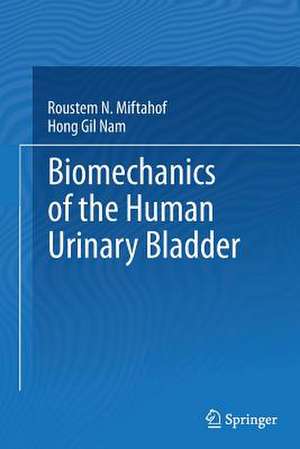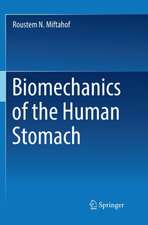Biomechanics of the Human Urinary Bladder
Autor Roustem N. Miftahof, Hong Gil Namen Limba Engleză Paperback – 6 mar 2015
| Toate formatele și edițiile | Preț | Express |
|---|---|---|
| Paperback (1) | 1088.96 lei 6-8 săpt. | |
| Springer Berlin, Heidelberg – 6 mar 2015 | 1088.96 lei 6-8 săpt. | |
| Hardback (1) | 1094.25 lei 6-8 săpt. | |
| Springer Berlin, Heidelberg – 3 feb 2013 | 1094.25 lei 6-8 săpt. |
Preț: 1088.96 lei
Preț vechi: 1146.26 lei
-5% Nou
Puncte Express: 1633
Preț estimativ în valută:
208.40€ • 216.77$ • 172.05£
208.40€ • 216.77$ • 172.05£
Carte tipărită la comandă
Livrare economică 14-28 aprilie
Preluare comenzi: 021 569.72.76
Specificații
ISBN-13: 9783642436475
ISBN-10: 3642436471
Pagini: 200
Ilustrații: XXI, 177 p. 43 illus., 10 illus. in color.
Dimensiuni: 155 x 235 x 11 mm
Greutate: 0.29 kg
Ediția:2013
Editura: Springer Berlin, Heidelberg
Colecția Springer
Locul publicării:Berlin, Heidelberg, Germany
ISBN-10: 3642436471
Pagini: 200
Ilustrații: XXI, 177 p. 43 illus., 10 illus. in color.
Dimensiuni: 155 x 235 x 11 mm
Greutate: 0.29 kg
Ediția:2013
Editura: Springer Berlin, Heidelberg
Colecția Springer
Locul publicării:Berlin, Heidelberg, Germany
Cuprins
1 The Bladder as a Dynamic System
1.1 Anatomy of the human urinary bladder
1.2 Detrusor muscle
1.2.1 Morphology of smooth muscle
1.2.2 Electromechanical activity of the detrusor
1.2.3 Pacemaker activity
1.3 Neurohormonal regulatory system
1.3.1 Anatomical considerations
1.3.2 Neurotransmission
1.3.3 Electrophysiological characteristics of neurons
1.4 Morphofunctional states in the bladder
1.4.1 Bladder filling
1.4.2 Bladder voiding
References
2. Investigations into Biomechanics of the Bladder
2.1 Biomechanics of the detrusor
2.2 Modelling of the bladder
References
3 Geometry of Thin Shells
3.1 The bladder as a thin biological shell
3.2 Geometry of the shell
3.3 Tensor of affine deformation
3.4 Equations of continuity of deformations
3.5 Equations of equilibrium
References
4 Essentials of the Theory of Soft Shells
4.1 Deformation of the shell
4.2 Principal deformations
4.3 Membrane forces
4.4 Principal membrane forces
4.5 Equations of motion in general curvilinear coordinates
4.6 Nets
4.7 Corollaries of the fundamental assumptions
References
5 Continual Model of the Detrusor
5.1 Basic assumptions
5.2 Model formulation
5.3 Biofactor 5.4 Special cases
References
6 A Model of the Detrusor Fasciculus
6.1 Formulation of the model
6.2 Physiological condition
6.3 Effects of pharmacological and extracellular ion changes on electromechanical activity of the detrusor
6.3.1 Changes in
6.3.2 L- and T-type channel antagonists
6.3.3 BKCa channel agonist/antagonist
6.3.4 K+ channel agonist/antagonist
6.3.5 - ATPase inhibitors
References
7 The Intrinsic Regulatory Pathways
7.1 Models of electrical activity of neurons
7.2 A model of neuronal assembly in the bladder
7.3 Response of the detrusor to stretching
7.4 Pharmacology of the neuronal pathway
7.4.1 Effect of iberiotoxin and charybdotoxin
7.4.2 Effect of ω-CgTX
7.4.3 Effect of TTX
7.4.4 Effect of purinoceptor agonists
7.4.5 Effect of protein kinase C activator
References
8 The Synaptic Transmission
8.1 A model of the synapse
8.2 cAMP-dependent pathway
8.3 PLC-dependent pathway
8.4 Physiological response
8.5 Variations in synaptic neurotransmission
8.5.1 Chloride salts of divalent cations
8.5.2 Change in [ ]
8.5.3 b - bungarotoxin
8.5.4 Botulinum toxin
8.5.5 Tetrodotoxin
8.5.6 High frequency stimulation 8.5.7 Inhibition of neuronal uptake-1 mechanism
References
9 Pharmacology of Detrusor Activity
9.1 Classes of drugs
9.2 Current pharmacological therapies of bladder dysfunction
9.3 Model of competitive antagonist action
9.4 Model of allosteric interaction
9.5 Allosteric modulation of competitive agonist/antagonist action
9.6 Effect of cholinergic antagonists/agonists
9.7 Inhibition of catechol-O-methyltransferase
9.8 Effect of b - adrenoceptor antagonists
References
10 Human Urinary Bladder as a Soft Biological Shell
10.1 Basic assumptions
10.2 Model of the bladder
10.3 Bladder mechanics
10.3.1 Filling stage
10.3.2 Voiding stage
10.3.3 Pharmacological modulation of voiding
11 Challenges in Human Urinary Bladder Mechanics
11.1 Urine-bladder interaction
11.2 Brain-bladder axis
11.3 Bladder substitutes
References
Index
1.1 Anatomy of the human urinary bladder
1.2 Detrusor muscle
1.2.1 Morphology of smooth muscle
1.2.2 Electromechanical activity of the detrusor
1.2.3 Pacemaker activity
1.3 Neurohormonal regulatory system
1.3.1 Anatomical considerations
1.3.2 Neurotransmission
1.3.3 Electrophysiological characteristics of neurons
1.4 Morphofunctional states in the bladder
1.4.1 Bladder filling
1.4.2 Bladder voiding
References
2. Investigations into Biomechanics of the Bladder
2.1 Biomechanics of the detrusor
2.2 Modelling of the bladder
References
3 Geometry of Thin Shells
3.1 The bladder as a thin biological shell
3.2 Geometry of the shell
3.3 Tensor of affine deformation
3.4 Equations of continuity of deformations
3.5 Equations of equilibrium
References
4 Essentials of the Theory of Soft Shells
4.1 Deformation of the shell
4.2 Principal deformations
4.3 Membrane forces
4.4 Principal membrane forces
4.5 Equations of motion in general curvilinear coordinates
4.6 Nets
4.7 Corollaries of the fundamental assumptions
References
5 Continual Model of the Detrusor
5.1 Basic assumptions
5.2 Model formulation
5.3 Biofactor 5.4 Special cases
References
6 A Model of the Detrusor Fasciculus
6.1 Formulation of the model
6.2 Physiological condition
6.3 Effects of pharmacological and extracellular ion changes on electromechanical activity of the detrusor
6.3.1 Changes in
6.3.2 L- and T-type channel antagonists
6.3.3 BKCa channel agonist/antagonist
6.3.4 K+ channel agonist/antagonist
6.3.5 - ATPase inhibitors
References
7 The Intrinsic Regulatory Pathways
7.1 Models of electrical activity of neurons
7.2 A model of neuronal assembly in the bladder
7.3 Response of the detrusor to stretching
7.4 Pharmacology of the neuronal pathway
7.4.1 Effect of iberiotoxin and charybdotoxin
7.4.2 Effect of ω-CgTX
7.4.3 Effect of TTX
7.4.4 Effect of purinoceptor agonists
7.4.5 Effect of protein kinase C activator
References
8 The Synaptic Transmission
8.1 A model of the synapse
8.2 cAMP-dependent pathway
8.3 PLC-dependent pathway
8.4 Physiological response
8.5 Variations in synaptic neurotransmission
8.5.1 Chloride salts of divalent cations
8.5.2 Change in [ ]
8.5.3 b - bungarotoxin
8.5.4 Botulinum toxin
8.5.5 Tetrodotoxin
8.5.6 High frequency stimulation 8.5.7 Inhibition of neuronal uptake-1 mechanism
References
9 Pharmacology of Detrusor Activity
9.1 Classes of drugs
9.2 Current pharmacological therapies of bladder dysfunction
9.3 Model of competitive antagonist action
9.4 Model of allosteric interaction
9.5 Allosteric modulation of competitive agonist/antagonist action
9.6 Effect of cholinergic antagonists/agonists
9.7 Inhibition of catechol-O-methyltransferase
9.8 Effect of b - adrenoceptor antagonists
References
10 Human Urinary Bladder as a Soft Biological Shell
10.1 Basic assumptions
10.2 Model of the bladder
10.3 Bladder mechanics
10.3.1 Filling stage
10.3.2 Voiding stage
10.3.3 Pharmacological modulation of voiding
11 Challenges in Human Urinary Bladder Mechanics
11.1 Urine-bladder interaction
11.2 Brain-bladder axis
11.3 Bladder substitutes
References
Index
Caracteristici
Step-by-step introduction to the subject of applied mathematical modeling of the human urinary bladder
Introduction to the theory of soft thin biological shells and its application
Computer simulation results provide insight into intricacies of complex physiological processes ?
Includes supplementary material: sn.pub/extras
Introduction to the theory of soft thin biological shells and its application
Computer simulation results provide insight into intricacies of complex physiological processes ?
Includes supplementary material: sn.pub/extras
























